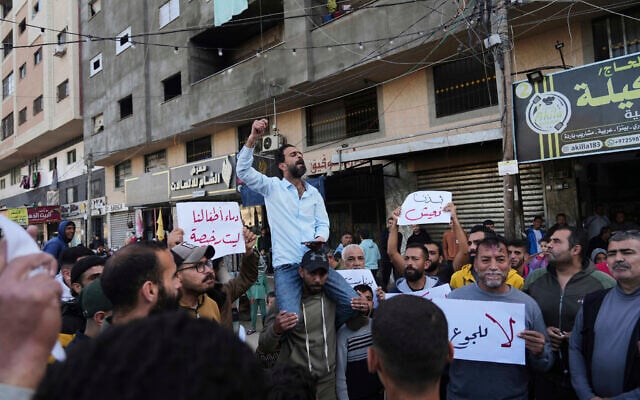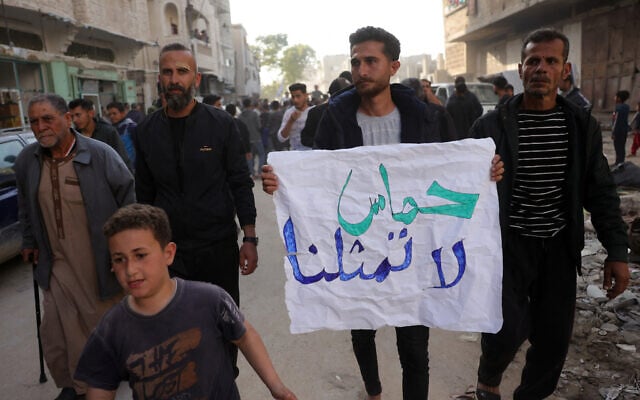The last three days have seen rare protests against Hamas bursting in several places in the Gaza Strip, with hundreds, even thousands, of Palestinians.
Demonstrations took place in Beit Lahiya and at the Jabalia refugee camp in the north, in the Sabra district of Gaza City, and in Khan Younis and Nuseirat in the south and in the center of the enclave. More specifically, anti-hamas demonstrations have not yet been documented in Deir Al-Balah de Central Gaza, where hundreds of thousands of displaced people from the north and southern took refuge, but there too, there were rallies opposing war and showing solidarity with Protestant Gazans elsewhere. It is not an isolated phenomenon.
The demonstrations presented direct calls to the eviction of Hamas, as well as anti-Israeli songs and requests to put an end to the war and the sufferings it caused to the civilians of Gaza. At the beginning of March, Israel stopped allowing Gaza to help Hamas to release more hostages as part of a first prolonged phase of the ceasefire agreement today. This decision increased prices and reduces the food supply to Gaza. The resumption of war almost two weeks ago included aerial strikes and renewed evacuation orders.
The civilian population suffers, but Hamas has been adamant to date, insisting on sticking to the initial agreement, which would have proceeded to a second phase in which all the remaining living hostages would be released, the FDI would end its withdrawal and a permanent cease-fire would take effect.
Dr. Harel Chorev, principal researcher at Moshe Dayan Center for studies in the Middle East and Africa at the University of Tel Aviv, believes that the roots of the demonstration precede the war triggered by the reign of Hamas in the Hamas Rèvre. cause.
Chorev saw preliminary signs of online disorders: “Two weeks ago, when this series of fights began, some Gazans displayed strong criticism of Hamas on social networks:“ We are marked by you; You have destroyed Gaza; You are a group of murderers. These are the same messages that have now presented (on the signs and in the songs) during the demonstrations.
وتتواصل مظاه VI # غغة والمطالبة Champr # قطاع_غغة .. والأهالي يطالبونها بالرحيل .. # أوقفوا_الحرب. # اوقفوا_الحرب. pic.twitter.com/kz4vfcjlm
– تيسير تربان / أبوعبدالل 4 CTE (@tyetertrban) March 27, 2025
Given that these are the first major manifestations in Gaza against Hamas since the start of the war, however, with a large part of Gaza in ruins and tens of thousands of deaths, this raises the question of why the substantial opposition of the public has only surfaced.
Hamza Hawidi, a Gazan who participated in a previous and less resonant demonstration against Hamas and who now lives in Germany, said that the anxiety and despair of the participants seem to have the carrying on the fear of the brutal fall of Hamas.
“The reason why people have not been doing this for a year and a half is that they were afraid,” he told Times of Israel in a zoom interview. “Ziad Abu Haya, a resident of Gaza, appeared in a television interview during the war and said a sentence:” Protect us from Hamas before protecting ourselves from the Jews. “”
Having been beaten for denouncing Hamas in August, Abu Haya would have been killed by Hamas in December. Hamas, Hawidi charged: “Beat him to death for this pain”.
“If I see someone expressing himself then being killed, I will not criticize Hamas,” continued Hawidi. Now, however, he said, it seems that the fear barrier has been broken.

The Palestinians of Deir Al-Balah, in the central band of Gaza, hold anti-war signs as a man sings slogans in support of the people of Beit Lahiya, in the north of Gaza, who protested against Hamas, March 26, 2025. (AP / Abdel Kareem Hana)
For almost two days, Hamas maintained the silence of the public concerning the demonstrations, nor approaching them or eliminating them violently. This was contrasting with 2019, when Hamas police quickly crushed a protest rash.
The senior Hamas, Bassem Naim, commented on the demonstrations for the first time on Wednesday evening, declaring that they should only be expected from people with massive destruction and that it was natural that they call the end of the Israeli aggression. He also subtly criticized calls to reverse the Hamas rule, claiming that “external actors exploited spontaneous manifestations to serve Israeli interests”.
Naim’s remarks, made in response to an interview with an Qatari television channel, have said that Hamas can no longer ignore the phenomenon and that its response strategy, for the moment, is to try to frame the manifestations as anti-war and anti-Israeli rather than anti-Hamas.
The demonstrations have indeed included votes condemning war due to prolonged suffering in Gaza, but also direct calls for the overthrow of Hamas, holding it in blame for the current situation in the band.
“Hamas is too smart to go out and crush the demonstrators forcefully,” said Hawidi. “He knows that the whole world is watching these demonstrations now. It aims to dismantle demonstrations by supervising them as demonstrations against war rather than against Hamas. “
Another Gazan who now lives abroad described another element in Hamas’ attempt to counter and remove demonstrations. Hamza Al-Masri, a Gazan who emigrated to Turkey and published protest images which he received in private people from Gaza, published a video saying that Hamas threatened him.
“This is the first video that I filmed, in a way a will,” he said. “I received death threats from Hamas leaders. I am very happy to help Gaza to express themselves; It’s a victory. For 18 years (under the Hamas rule), no one in Gaza could speak. If you don’t see me anymore, be happy. If they kill me or Kidnate – it is in the hands of God. “
الان :: و لليوم الثالث على التents
شاركو وو e# اوقفوا_الحرب. pic.twitter.com/cctimsvkb3– الناشط حمزة المصري (@ hamza198708) March 27, 2025
The Dayan Center chorev sees another reason why Hamas does not violently target the demonstrations directly and publicly for the moment. “The fact that these protests occur during (a period of recovery) makes the task difficult for Hamas. In other words, if Hamas agents come out and suppress (rallies) with weapons, they become an easy target for Israeli drones.”
Instead, for the moment, he said: “They prefer to threaten local leaders in Gaza, including eminent clan leaders.”
The chances that the successful demonstrations remain vague. There are two million residents in Gaza, with tens of thousands in the Hamas military wing. The reversal of the regime would require the internal collapse of the strongest armed force in Gaza.

A young Palestinian wears a banner who reads in Arabic “Hamas does not represent us” during an anti-hamas demonstration, calling at the end of the war with Israel, in Beit Lahiya in the Northern Gaza Strip on March 26, 2025. (AFP)
Chorev does not exclude this, and thinks that the military campaign of Asrael has resumed and the influx of reduced aid could help. “It is possible that ultimately, those who currently fill the ranks of the Hamas military wing abandoning it because the food and water they have received in exchange for enrollment will be exhausted, due to the continuous ban on humanitarian aid in Gaza,” he said.
Hamas has recruited individuals, some very young people, “who are not as ideologically committed as those who preceded them and who have been killed,” he said. “It could have an impact. The current blockade could trap Hamas in a very difficult situation.”
Chorev also underlined the “American green light” for Israel to maintain the blockage of the aid: “I met a TDI officer who used to dispense the previous weekly American administration on humanitarian aid that entered Gaza. The Americans were very focused on the civilian population.
Even if the current wave of protests finally refused or is deleted, Chorev thinks that it will not be vain: “Hamas is a social movement that fits into the hearts of people, and once its image is damaged, it loses that holds.
Hawidi believes that manifestations alone will not bring Hamas to fall, but consider them very important, including symbolically: “We do not want Hamas to fall while people remain silent. People should not think that Hamas overturns is an Israeli demand; It is a demand from the population with Hamas.
However, Hawidi expresses a certain optimism about what is happening, including in the context of his own decision to leave Gaza in the summer of 2023: “I did not leave Gaza because I hate that. I left because there was no hope of change. Everyone treated the reign of Hamas in Gaza as a permanent reality, and that was everything.
“When I left, if you said that Hamas was a terrorist organization, it meant that you would be executed. But now I see my people saying by themselves:” Hamas is a terrorist organization. “”


